.
27.10.2015
Dawn Heads Toward Final Orbit
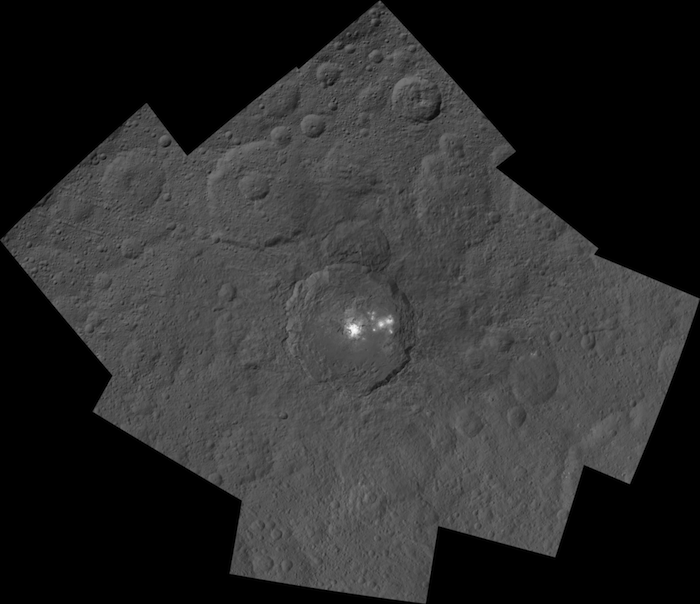
This mosaic shows Ceres' Occator crater and surrounding terrain from an altitude of 915 miles (1,470 kilometers), as seen by NASA's Dawn spacecraft. Occator is about 60 miles (90 kilometers) across and 2 miles (4 kilometers) deep.
Credits: NASA/JPL-Caltech/UCLA/MPS/DLR/IDA
.
Mission Status Report
NASA's Dawn spacecraft fired up its ion engine on Friday, Oct. 23, to begin its journey toward its fourth and final science orbit at dwarf planet Ceres. The spacecraft completed two months of observations from an altitude of 915 miles (1,470 kilometers) and transmitted extensive imagery and other data to Earth.
The spacecraft is now on its way to the final orbit of the mission, called the low-altitude mapping orbit. Dawn will spend more than seven weeks descending to this vantage point, which will be less than 235 miles (380 kilometers) from the surface of Ceres. In mid-December, Dawn will begin taking observations from this orbit, including images at a resolution of 120 feet (35 meters) per pixel.
Of particular interest to the Dawn team is Occator crater, home to Ceres' bright spots. A new mosaic of images from Dawn's third science orbit highlights the crater and surrounding terrain.
Quelle: NASA
-
Update: 21.11.2015
.
First Complete Look at Ceres' Poles
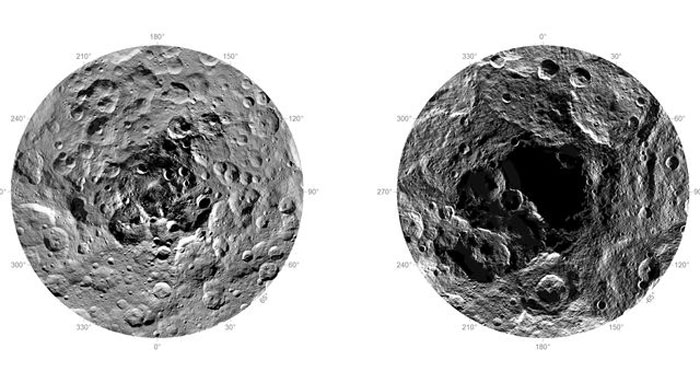
Researchers from NASA's Dawn mission have composed the first comprehensive views of the north (left) and south pole regions (right) of dwarf planet Ceres, using images obtained by the Dawn spacecraft. The images were taken between Aug. 17 and Oct. 23, 2015, from an altitude of 915 miles (1,470 kilometers).
The region around the south pole appears black in this view because this area has been in shade ever since Dawn's arrival on March 6, 2015, and is therefore not visible.
At the north polar region, craters Jarovit, Ghanan and Asari are visible, as well as the mountain Ysolo Mons. Near the south pole, craters Attis and Zadeni can be seen.
Detailed maps of the polar regions allow researchers to study the craters in this area and compare them to those covering other parts of Ceres. Variations in shape and complexity can point to different surface compositions. In addition, the bottoms of some craters located close to the poles receive no sunlight throughout Ceres' orbit around the sun. Scientists want to investigate whether surface ice can be found there.
Quelle: NASA
-
Update: 9.12.2015
.
New Clues to Ceres' Bright Spots and Origins
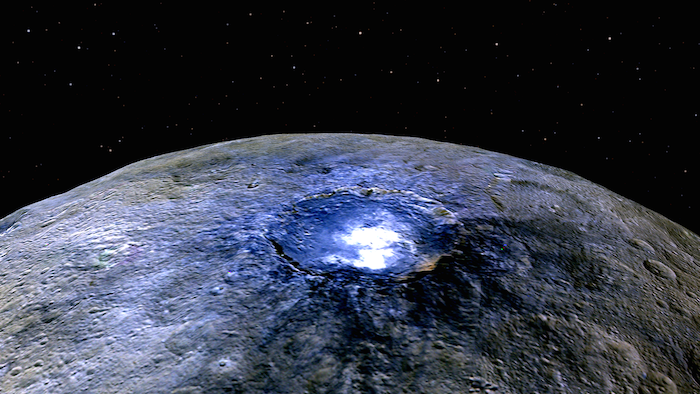
This representation of Ceres' Occator Crater in false colors shows differences in the surface composition. Image Credit: NASA/JPL-Caltech/UCLA/MPS/DLR/IDA
Watch the Ceres / Occator Rotation Movie
Ceres reveals some of its well-kept secrets in two new studies in the journal Nature, thanks to data from NASA's Dawn spacecraft. They include highly anticipated insights about mysterious bright features found all over the dwarf planet's surface.
In one study, scientists identify this bright material as a kind of salt. The second study suggests the detection of ammonia-rich clays, raising questions about how Ceres formed.
About the Bright Spots
Ceres has more than 130 bright areas, and most of them are associated with impact craters. Study authors, led by Andreas Nathues at Max Planck Institute for Solar System Research, G?ttingen, Germany, write that the bright material is consistent with a type of magnesium sulfate called hexahydrite. A different type of magnesium sulfate is familiar on Earth as Epsom salt.
Nathues and colleagues, using images from Dawn's framing camera, suggest that these salt-rich areas were left behind when water-ice sublimated in the past. Impacts from asteroids would have unearthed the mixture of ice and salt, they say.
"The global nature of Ceres' bright spots suggests that this world has a subsurface layer that contains briny water-ice," Nathues said.
A New Look at Occator
The surface of Ceres, whose average diameter is 584 miles (940 kilometers), is generally dark -- similar in brightness to fresh asphalt -- study authors wrote. The bright patches that pepper the surface represent a large range of brightness, with the brightest areas reflecting about 50 percent of sunlight shining on the area. But there has not been unambiguous detection of water ice on Ceres; higher-resolution data are needed to settle this question.
The inner portion of a crater called Occator contains the brightest material on Ceres. Occator itself is 60 miles (90 kilometers) in diameter, and its central pit, covered by this bright material, measures about 6 miles (10 kilometers) wide and 0.3 miles (0.5 kilometers) deep. Dark streaks, possibly fractures, traverse the pit. Remnants of a central peak, which was up to 0.3 miles (0.5 kilometers) high, can also be seen.
With its sharp rim and walls, and abundant terraces and landslide deposits, Occator appears to be among the youngest features on Ceres. Dawn mission scientists estimate its age to be about 78 million years old.
Study authors write that some views of Occator appear to show a diffuse haze near the surface that fills the floor of the crater. This may be associated with observations of water vapor at Ceres by the Herschel space observatory that were reported in 2014. The haze seems to be present in views during noon, local time, and absent at dawn and dusk, study authors write. This suggests that the phenomenon resembles the activity at the surface of a comet, with water vapor lifting tiny particles of dust and residual ice. Future data and analysis may test this hypothesis and reveal clues about the process causing this activity.
"The Dawn science team is still discussing these results and analyzing data to better understand what is happening at Occator," said Chris Russell, principal investigator of the Dawn mission, based at the University of California, Los Angeles.
.
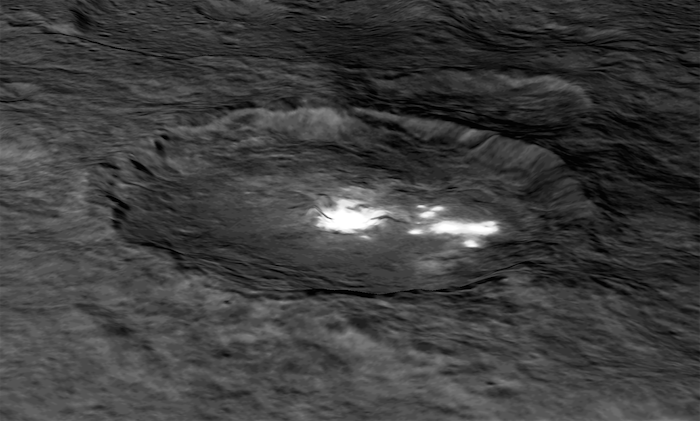
An image of Occator Crater draped over a digital terrain model provides a 3-D-like perspective view of the impact structure. Image Credit: NASA/JPL-Caltech/UCLA/MPS/DLR/IDA
.
The Importance of Ammonia
In the second Nature study, members of the Dawn science team examined the composition of Ceres and found evidence for ammonia-rich clays. They used data from the visible and infrared mapping spectrometer, a device that looks at how various wavelengths of light are reflected by the surface, allowing minerals to be identified.
Ammonia ice by itself would evaporate on Ceres today, because the dwarf planet is too warm. However, ammonia molecules could be stable if present in combination with (i.e. chemically bonded to) other minerals.
The presence of ammoniated compounds raises the possibility that Ceres did not originate in the main asteroid belt between Mars and Jupiter, where it currently resides, but instead might have formed in the outer solar system. Another idea is that Ceres formed close to its present position, incorporating materials that drifted in from the outer solar system - near the orbit of Neptune, where nitrogen ices are thermally stable.
"The presence of ammonia-bearing species suggests that Ceres is composed of material accreted in an environment where ammonia and nitrogen were abundant. Consequently, we think that this material originated in the outer cold solar system," said Maria Cristina De Sanctis, lead author of the study, based at the National Institute of Astrophysics, Rome.
In comparing the spectrum of reflected light from Ceres to meteorites, scientists found some similarities. Specifically, they focused on the spectra, or chemical fingerprints, of carbonaceous chondrites, a type of carbon-rich meteorite thought to be relevant analogues for the dwarf planet. But these are not good matches for all wavelengths that the instrument sampled, the team found. In particular, there were distinctive absorption bands, matching mixtures containing ammoniated minerals, associated with wavelengths that can't be observed from Earth-based telescopes.
The scientists note another difference is that these carbonaceous chondrites have bulk water contents of 15 to 20 percent, while Ceres' content is as much as 30 percent.
"Ceres may have retained more volatiles than these meteorites, or it could have accreted the water from volatile-rich material," De Sanctis said.
The study also shows that daytime surface temperatures on Ceres span from minus 136 degrees to minus 28 degrees Fahrenheit (180 to 240 Kelvin). The maximum temperatures were measured in the equatorial region. The temperatures at and near the equator are generally too high to support ice at the surface for a long time, study authors say, but data from Dawn's next orbit will reveal more details.
As of this week, Dawn has reached its final orbital altitude at Ceres, about 240 miles (385 kilometers) from the surface of the dwarf planet. In mid-December, Dawn will begin taking observations from this orbit, including images at a resolution of 120 feet (35 meters) per pixel, infrared, gamma ray and neutron spectra, and high-resolution gravity data.
.
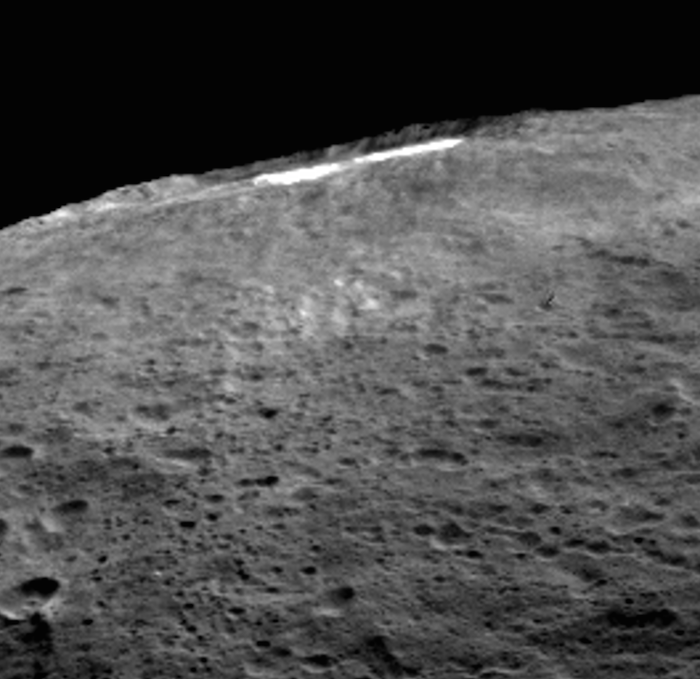
A group of scientists from NASA's Dawn mission suggests that when sunlight reaches Ceres' Occator Crater, a kind of thin haze of dust and evaporating water forms there. Image Credit: NASA/JPL-Caltech/UCLA/MPS/DLR/IDA
.
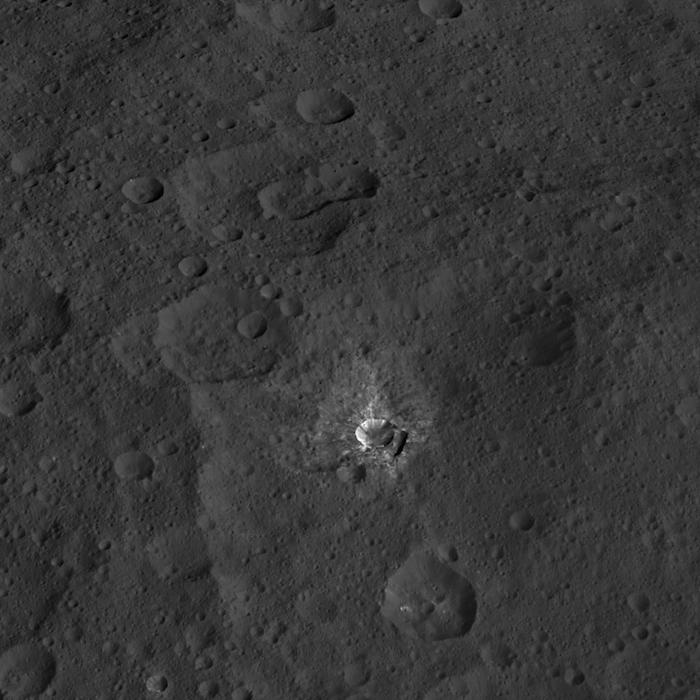
Oxo Crater, which is about 6 miles (9 kilometers) in diameter, is the second-brightest feature on Ceres.
Dawn's mission is managed by the Jet Propulsion Laboratory for NASA. Dawn is a project of the directorate's Discovery Program, managed by NASA's Marshall Space Flight Center in Huntsville, Alabama. UCLA is responsible for overall Dawn mission science. Orbital ATK Inc., in Dulles, Virginia, designed and built the spacecraft. The German Aerospace Center, Max Planck Institute for Solar System Research, Italian Space Agency and Italian National Astrophysical Institute are international partners on the mission team.
Quelle: NASA
.
Update: 22.12.2015
.
Lowdown on Ceres: Images From Dawn's Closest Orbit
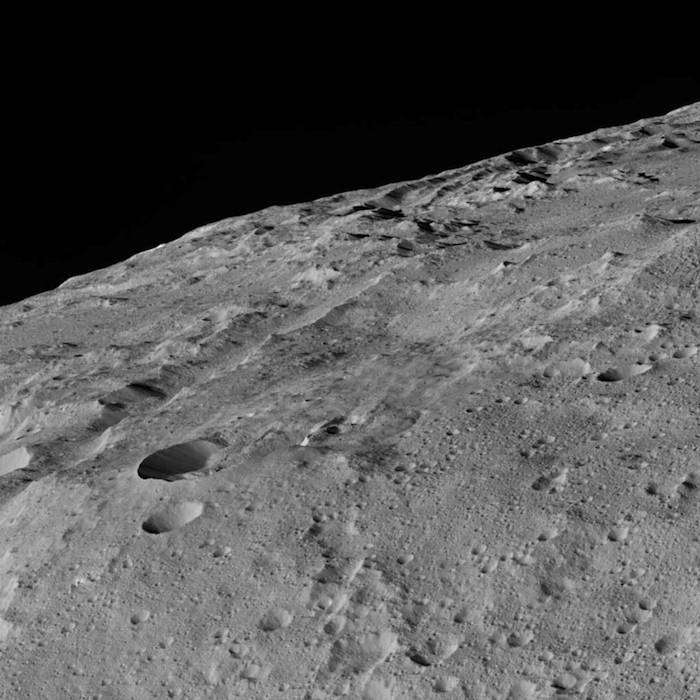
This image of Ceres was taken in Dawn's low-altitude mapping orbit around a crater chain called Gerber Catena.
.
NASA's Dawn spacecraft, cruising in its lowest and final orbit at dwarf planet Ceres, has delivered the first images from its best-ever viewpoint. The new images showcase details of the cratered and fractured surface. 3-D versions of two of these views are also available.
Dawn took these images of the southern hemisphere of Ceres on Dec. 10, at an approximate altitude of 240 miles (385 kilometers), which is its lowest-ever orbital altitude. Dawn will remain at this altitude for the rest of its mission, and indefinitely afterward. The resolution of the new images is about 120 feet (35 meters) per pixel.
Among the striking views is a chain of craters called Gerber Catena, located just west of the large crater Urvara. Troughs are common on larger planetary bodies, caused by contraction, impact stresses and the loading of the crust by large mountains -- Olympus Mons on Mars is one example. The fracturing found all across Ceres' surface indicates that similar processes may have occurred there, despite its smaller size (the average diameter of Ceres is 584 miles, or 940 kilometers). Many of the troughs and grooves on Ceres were likely formed as a result of impacts, but some appear to be tectonic, reflecting internal stresses that broke the crust.
"Why they are so prominent is not yet understood, but they are probably related to the complex crustal structure of Ceres," said Paul Schenk, a Dawn science team member at the Lunar and Planetary Institute, Houston.
The images were taken as part of a test of Dawn's backup framing camera. The primary framing camera, which is essentially identical, began its imaging campaign at this lowest orbit on Dec. 16. Both cameras are healthy.
Dawn's other instruments also began their intense period of observations this month. The visible and infrared mapping spectrometer will help identify minerals by looking at how various wavelengths of light are reflected by the surface of Ceres. The gamma ray and neutron detector is also active. By measuring the energies and numbers of gamma rays and neutrons, two components of nuclear radiation, it will help scientists determine the abundances of some elements on Ceres.
Earlier in December, Dawn science team members revealed that the bright material found in such notable craters as Occator is consistent with salt -- and proposed that a type of magnesium sulfate called hexahydrite may be present. A different group of Dawn scientists found that Ceres also contains ammoniated clays. Because ammonia is abundant in the outer solar system, this finding suggests that Ceres could have formed in the vicinity of Neptune and migrated inward, or formed in place with material that migrated in from the outer solar system.
"As we take the highest-resolution data ever from Ceres, we will continue to examine our hypotheses and uncover even more surprises about this mysterious world," said Chris Russell, principal investigator of the Dawn mission, based at the University of California, Los Angeles.
Dawn is the first mission to visit a dwarf planet, and the first mission outside the Earth-moon system to orbit two distinct solar system targets. It orbited protoplanet Vesta for 14 months in 2011 and 2012, and arrived at Ceres on March 6, 2015.
Dawn's mission is managed by the Jet Propulsion Laboratory for NASA's Science Mission Directorate in Washington. Dawn is a project of the directorate's Discovery Program, managed by NASA's Marshall Space Flight Center in Huntsville, Alabama. UCLA is responsible for overall Dawn mission science. Orbital ATK Inc., in Dulles, Virginia, designed and built the spacecraft. The German Aerospace Center, Max Planck Institute for Solar System Research, Italian Space Agency and Italian National Astrophysical Institute are international partners on the mission team.
.
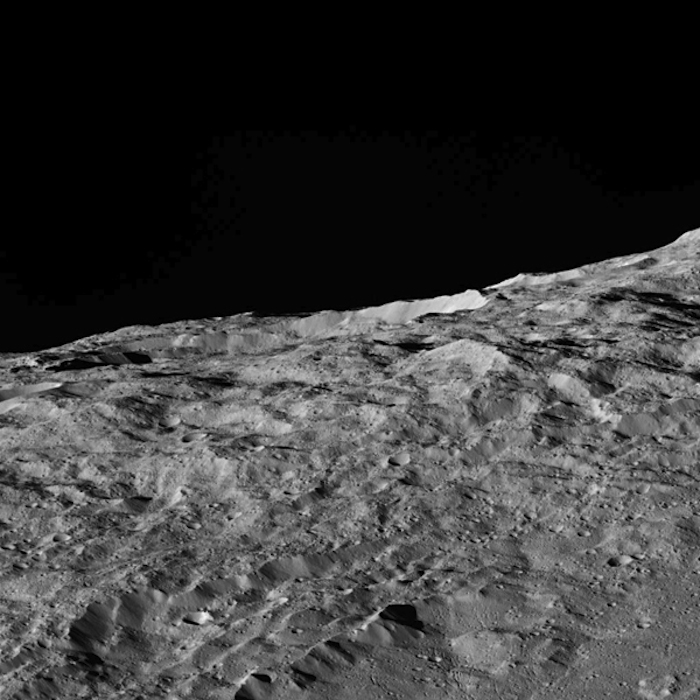
This 3-D image, best viewed with red-blue glasses, shows a portion of Ceres' southern hemisphere.
.
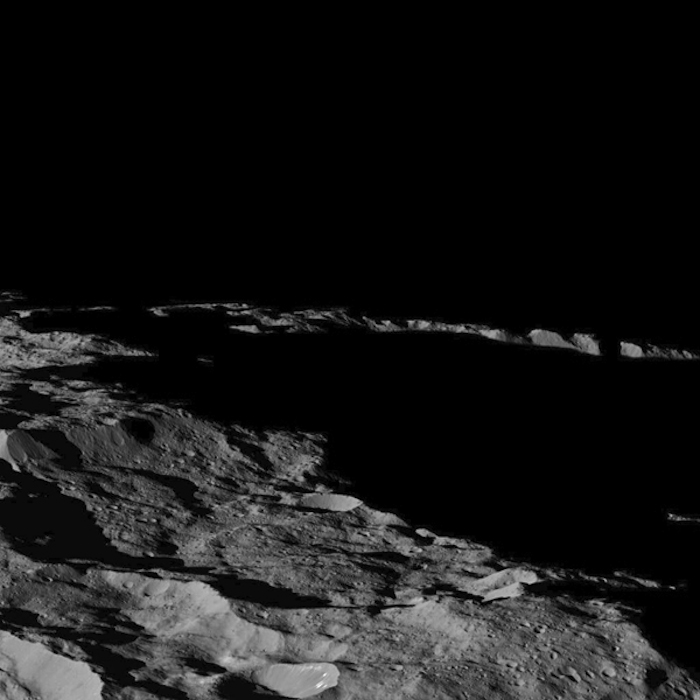
This view of Ceres, taken by NASA's Dawn spacecraft on December 10, shows an area in southern hemisphere of the dwarf planet. It is located at approximately 85.6 south longitude, 176.6 east longitude.
This part of Ceres, near the south pole, has such long shadows because, from the perspective of this location, the sun is near the horizon. At the time this image was taken, the sun was 4 degrees north of the equator. If you were standing this close to Ceres' south pole, the sun would never get high in the sky during the course of a nine-hour Cerean day.
The spacecraft took this image in its low-altitude mapping orbit from an approximate distance of 240 miles (385 kilometers) from Ceres.
.
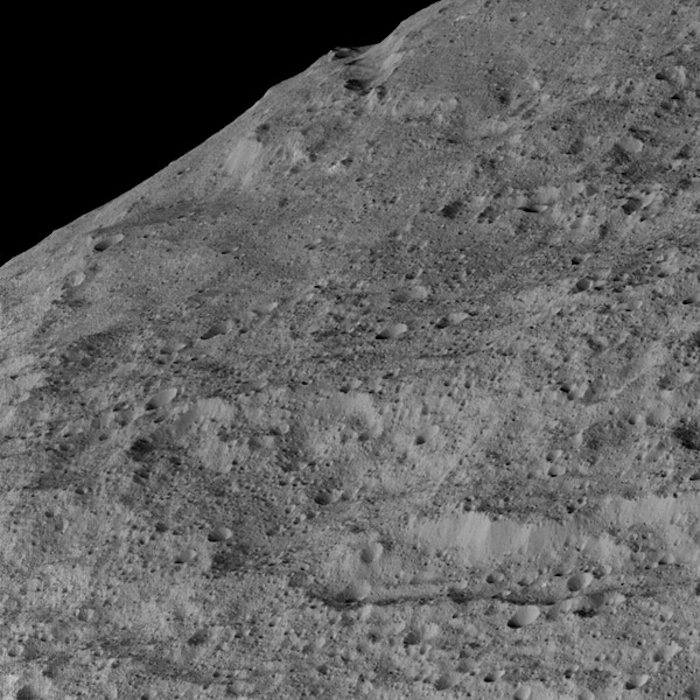
This view of Ceres, taken by NASA's Dawn spacecraft on December 10, shows an area in the southern mid-latitudes of the dwarf planet. It is located in an area around a crater chain called Samhain Catena, at approximately 23.2 south latitude, 216.8 east longitude.
The spacecraft took this image in its low-altitude mapping orbit from an approximate distance of 240 miles (385 kilometers) from Ceres.
.
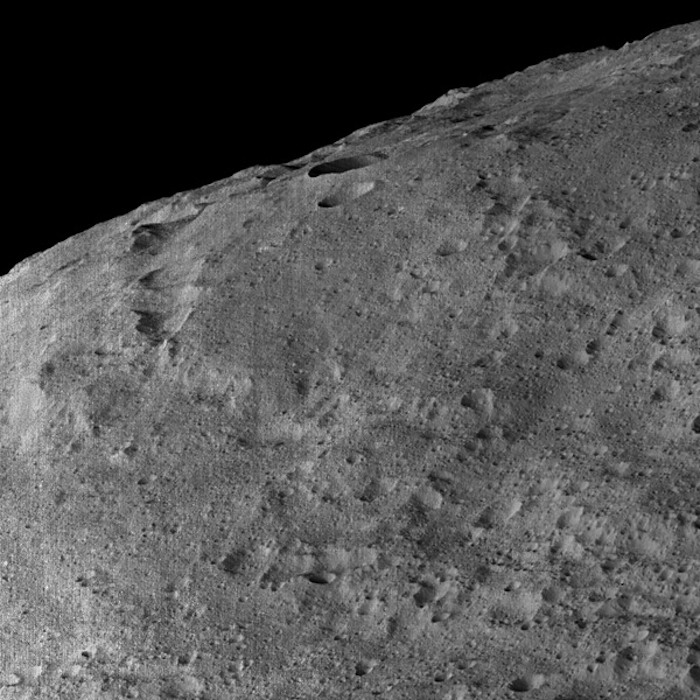
This view of Ceres, taken by NASA's Dawn spacecraft on December 10, shows an area in the southern mid-latitudes of the dwarf planet. It is located at approximately 29.4 south latitude, 213.1 east longitude.
The spacecraft took this image in its low-altitude mapping orbit from an approximate distance of 240 miles (385 kilometers) from Ceres.
Quelle: NASA
-
Update: 12.01.2016
.
New Details On Ceres Seen in Dawn Images
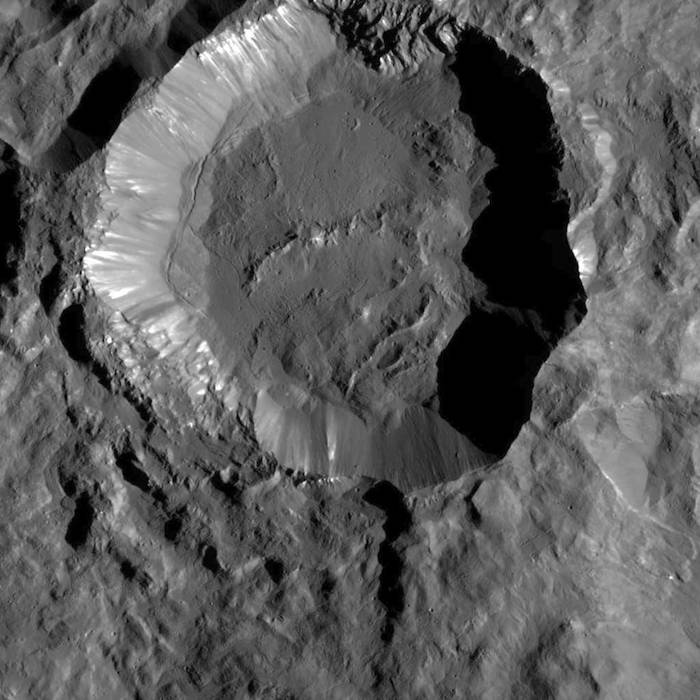
This image from NASA's Dawn spacecraft shows Kupalo Crater, one of the youngest craters on Ceres. The crater has bright material exposed on its rim and walls, which could be salts. Its flat floor likely formed from impact melt and debris.
Credits: NASA/JPL-Caltech/UCLA/MPS/DLR/IDA
.
Features on dwarf planet Ceres that piqued the interest of scientists throughout 2015 stand out in exquisite detail in the latest images from NASA's Dawn spacecraft, which recently reached its lowest-ever altitude at Ceres.
Dawn took these images near its current altitude of 240 miles (385 kilometers) from Ceres, between Dec. 19 and 23, 2015.
Kupalo Crater, one of the youngest craters on Ceres, shows off many fascinating attributes at the high image resolution of 120 feet (35 meters) per pixel. The crater has bright material exposed on its rim, which could be salts, and its flat floor likely formed from impact melt and debris. Researchers will be looking closely at whether this material is related to the "bright spots" of Occator Crater. Kupalo, which measures 16 miles (26 kilometers) across and is located at southern mid-latitudes, is named for the Slavic god of vegetation and harvest.
"This crater and its recently-formed deposits will be a prime target of study for the team as Dawn continues to explore Ceres in its final mapping phase," said Paul Schenk, a Dawn science team member at the Lunar and Planetary Institute, Houston.
Dawn's low vantage point also captured the dense network of fractures on the floor of 78-mile-wide (126-kilometer-wide) Dantu Crater. One of the youngest large craters on Earth's moon, called Tycho, has similar fractures. This cracking may have resulted from the cooling of impact melt, or when the crater floor was uplifted after the crater formed.
A 20-mile (32-kilometer) crater west of Dantu is covered in steep slopes, called scarps, and ridges. These features likely formed when the crater partly collapsed during the formation process. The curvilinear nature of the scarps resembles those on the floor of Rheasilvia, the giant impact crater on protoplanet Vesta, which Dawn orbited from 2011 to 2012.
Dawn's other instruments also began studying Ceres intensively in mid-December. The visible and infrared mapping spectrometer is examining how various wavelengths of light are reflected by Ceres, which will help identify minerals present on its surface.
Dawn's gamma ray and neutron detector (GRaND) is also keeping scientists busy. Data from GRaND help researchers understand the abundances of elements in Ceres' surface, along with details of the dwarf planet's composition that hold important clues about how it evolved.
The spacecraft will remain at its current altitude for the rest of its mission, and indefinitely afterward. The end of the prime mission will be June 30, 2016.
"When we set sail for Ceres upon completing our Vesta exploration, we expected to be surprised by what we found on our next stop. Ceres did not disappoint," said Chris Russell, principal investigator for the Dawn mission, based at the University of California, Los Angeles. "Everywhere we look in these new low- altitude observations, we see amazing landforms that speak to the unique character of this most amazing world."
Dawn is the first mission to visit a dwarf planet, and the first mission outside the Earth-moon system to orbit two distinct solar system targets. After orbiting Vesta for 14 months in 2011 and 2012, it arrived at Ceres on March 6, 2015.
Dawn's mission is managed by the Jet Propulsion Laboratory for NASA's Science Mission Directorate in Washington. Dawn is a project of the directorate's Discovery Program, managed by NASA's Marshall Space Flight Center in Huntsville, Alabama. UCLA is responsible for overall Dawn mission science. Orbital ATK Inc., in Dulles, Virginia, designed and built the spacecraft. The German Aerospace Center, Max Planck Institute for Solar System Research, Italian Space Agency and Italian National Astrophysical Institute are international partners on the mission team.
.
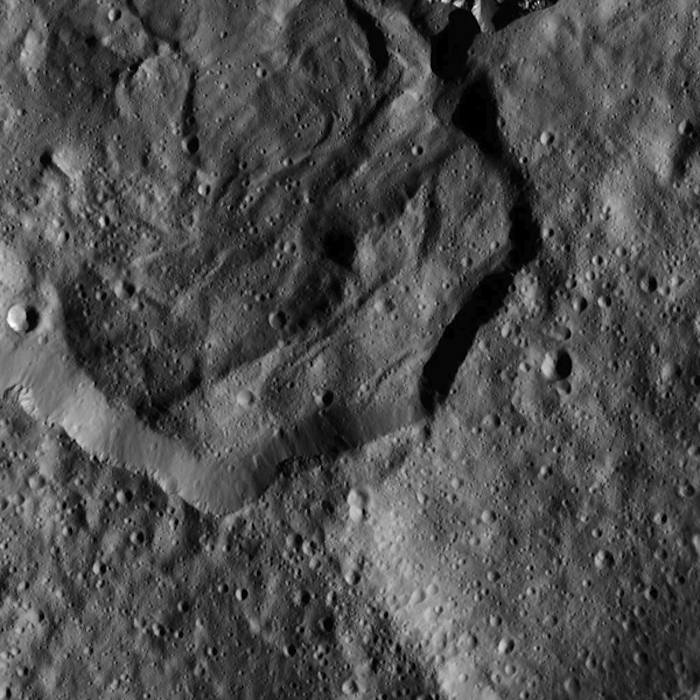
This image from NASA's Dawn spacecraft shows part of Messor Crater (25 miles or 40 kilometers, wide), located at northern mid-latitudes on Ceres. The scene shows an older crater in which a large lobe-shaped flow partly covers the northern (top) part of the crater floor. The flow is a mass of material ejected when a younger crater formed just north of the rim.
Dawn took this image on Dec. 19 from its low-altitude mapping orbit (LAMO) from an approximate altitude of 240 miles (385 kilometers) above Ceres. The image resolution is 120 feet (35 meters) per pixel.
.
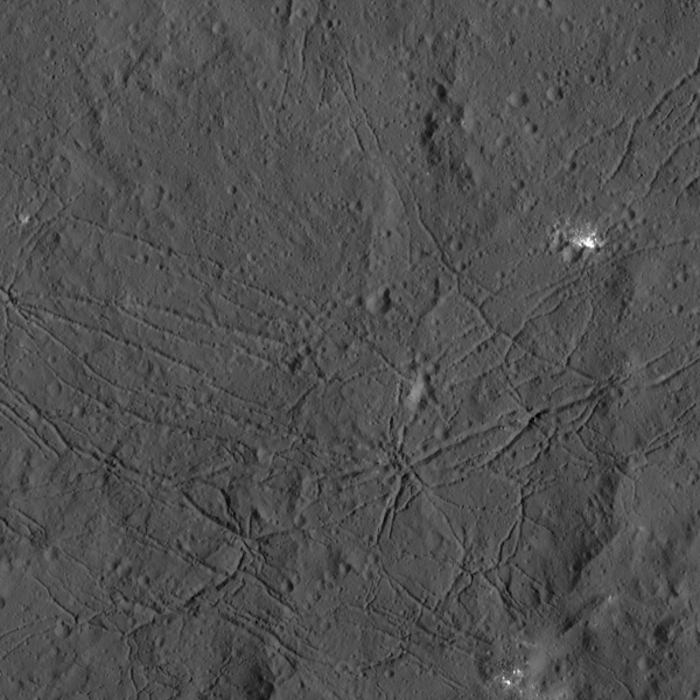
The fractured floor of Dantu Crater on Ceres is seen in this image from NASA's Dawn spacecraft. Similar fractures are seen in Tycho, one of the youngest large craters on Earth's moon. This cracking may have resulted from the cooling of impact melt, or when the crater floor was uplifted after the crater formed.
Dantu was imaged earlier in Dawn's science mission at Ceres -- during Survey orbit (see PIA19609) and from the high altitude mapping orbit, or HAMO (see PIA19993).
Dawn took this image on Dec. 21 from its low-altitude mapping orbit (LAMO) at an approximate altitude of 240 miles (385 kilometers) above Ceres. The image resolution is 120 feet (35 meters) per pixel.
.
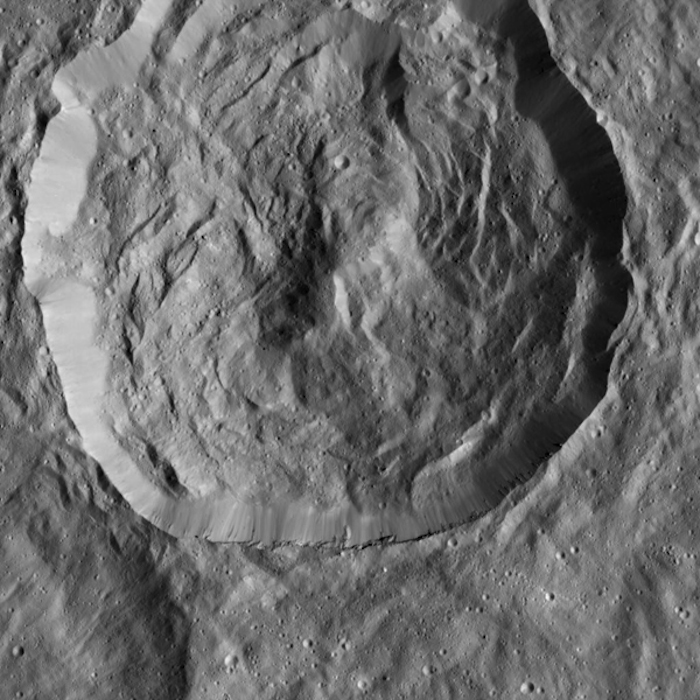
NASA's Dawn spacecraft viewed this Cerean crater, which is covered in ridges and steep slopes, called scarps on Dec. 23, 2015. These features likely resulted when the crater partly collapsed during its formation. The curvilinear nature of the scarps resembles those on the floor of Rheasilvia, the giant impact crater on Vesta, which Dawn orbited from 2011 to 2012.
The 20-mile-wide (32-kilometer-wide) crater is located just west of the larger, named crater Dantu (see PIA20193), at northern mid-latitudes on Ceres. Both of these impact features were captured during Dawn's Survey orbit (see PIA19609).
Dawn took this image from its low-altitude mapping orbit (LAMO) at an approximate altitude of 240 miles (385 kilometers) above Ceres. The image resolution is 120 feet (35 meters) per pixel.
Quelle: NASA
-
Update: 7.03.2016
.
Ahuna Mons Perspective View
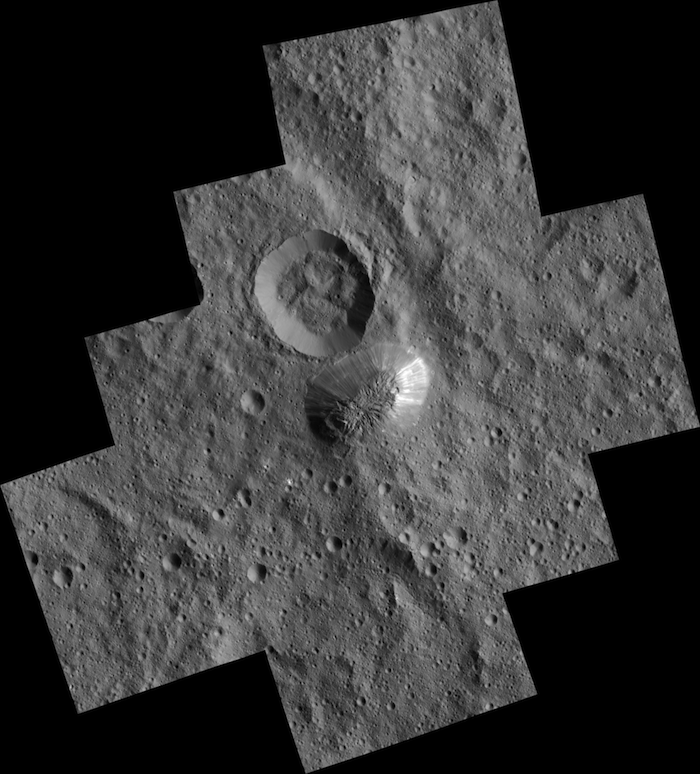
Dawn's First Year at Ceres: A Mountain Emerges
One year ago, on March 6, 2015, NASA's Dawn spacecraft slid gently into orbit around Ceres, the largest body in the asteroid belt between Mars and Jupiter. Since then, the spacecraft has delivered a wealth of images and other data that open an exciting new window to the previously unexplored dwarf planet.
"Ceres has defied our expectations and surprised us in many ways, thanks to a year's worth of data from Dawn. We are hard at work on the mysteries the spacecraft has presented to us," said Carol Raymond, deputy principal investigator for the mission, based at NASA's Jet Propulsion Laboratory, Pasadena, California.
Among Ceres' most enigmatic features is a tall mountain the Dawn team named Ahuna Mons. This mountain appeared as a small, bright-sided bump on the surface as early as February 2015 from a distance of 29,000 miles (46,000 kilometers), before Dawn was captured into orbit. As Dawn circled Ceres at increasingly lower altitudes, the shape of this mysterious feature began to come into focus. From afar, Ahuna Mons looked to be pyramid-shaped, but upon closer inspection, it is best described as a dome with smooth, steep walls.
Dawn's latest images of Ahuna Mons, taken 120 times closer than in February 2015, reveal that this mountain has a lot of bright material on some of its slopes, and less on others. On its steepest side, it is about 3 miles (5 kilometers) high. The mountain has an average overall height of 2.5 miles (4 kilometers). It rises higher than Washington's Mount Rainier and California's Mount Whitney.
Scientists are beginning to identify other features on Ceres that could be similar in nature to Ahuna Mons, but none is as tall and well-defined as this mountain.
"No one expected a mountain on Ceres, especially one like Ahuna Mons," said Chris Russell, Dawn's principal investigator at the University of California, Los Angeles. "We still do not have a satisfactory model to explain how it formed."
About 420 miles (670 kilometers) northwest of Ahuna Mons lies the now-famous Occator Crater. Before Dawn arrived at Ceres, images of the dwarf planet from NASA's Hubble Space Telescope showed a prominent bright patch on the surface. As Dawn approached Ceres, it became clear that there were at least two spots with high reflectivity. As the resolution of images improved, Dawn revealed to its earthly followers that there are at least 10 bright spots in this crater alone, with the brightest area on the entire body located in the center of the crater. It is not yet clear whether this bright material is the same as the material found on Ahuna Mons.
"Dawn began mapping Ceres at its lowest altitude in December, but it wasn't until very recently that its orbital path allowed it to view Occator's brightest area. This dwarf planet is very large and it takes a great many orbital revolutions before all of it comes into view of Dawn's camera and other sensors," said Marc Rayman, Dawn's chief engineer and mission director at JPL.
Researchers will present new images and other insights about Ceres at the 47th Lunar and Planetary Science Conference, during a press briefing on March 22 in The Woodlands, Texas.
When it arrived at Ceres on March 6, 2015, Dawn made history as the first mission to reach a dwarf planet, and the first to orbit two distinct extraterrestrial targets. The mission conducted extensive observations of Vesta in 2011-2012.
Dawn's mission is managed by JPL for NASA's Science Mission Directorate in Washington. Dawn is a project of the directorate's Discovery Program, managed by NASA's Marshall Space Flight Center in Huntsville, Alabama. UCLA is responsible for overall Dawn mission science. Orbital ATK Inc., in Dulles, Virginia, designed and built the spacecraft. The German Aerospace Center, Max Planck Institute for Solar System Research, Italian Space Agency and Italian National Astrophysical Institute are international partners on the mission team.
.
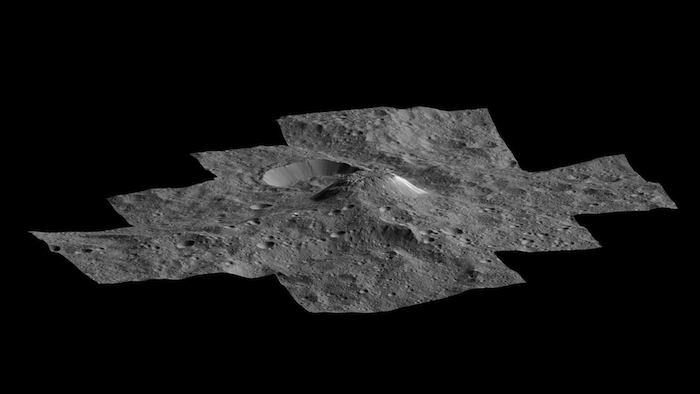
This side-perspective view of the mysterious mountain Ahuna Mons was made with images from NASA's Dawn spacecraft.
.
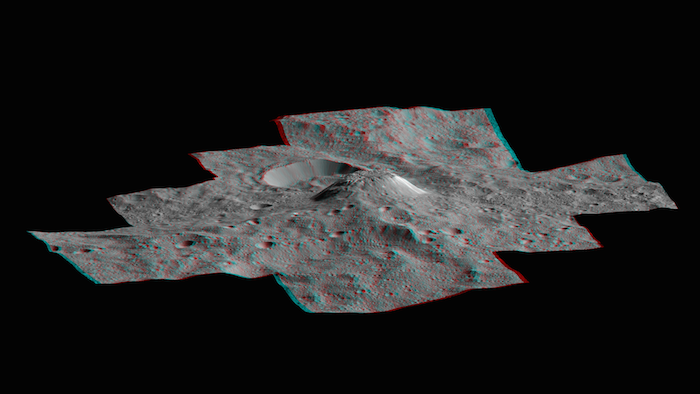
This side-perspective view of the mysterious mountain Ahuna Mons in 3D was made with images from NASA's Dawn spacecraft.
Quelle: NASA
-
Update: 17.03.2016
.
Ceres’s mysterious spots brighten and dim unexpectedly
The bright spots on the dwarf planet Ceres have been puzzling the world for months now. Are they made of ice? Salt? Aliens?
Okay, okay, so we're pretty positive that aliens aren't involved — NASA's Dawn orbiter has been circling the dwarf planet for over a year now, so they'd have to be pretty good at hide-and-seek, to say the least.
[Fly over the dwarf planet Ceres in NASA’s latest video]
But the mystery of the strange bright spots has just deepened: According to a study published Wednesday in the Monthly Notices of the Royal Astronomical Society, the spots are brightening and dimming as the little world warms up and cools down – but those changes don't happen with the regularity the scientists expected.
.
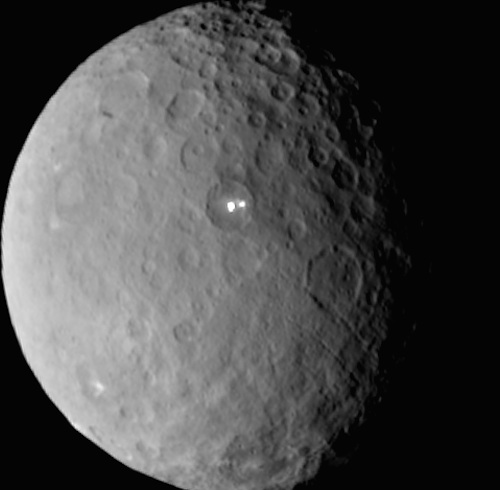
"As soon as the Dawn spacecraft revealed the mysterious bright spots on the surface of Ceres, I immediately thought of the possible measurable effects from Earth," lead author Paolo Molaro of the INAF-Trieste Astronomical Observatory said in a statement. "As Ceres rotates the spots approach the Earth and then recede again, which affects the spectrum of the reflected sunlight arriving at Earth."
Molaro and his colleagues were surprised to see that the spot brightness fluctuated in a way they hadn't predicted, based on Ceres's orbit. "We did find the expected changes to the spectrum from the rotation of Ceres, but with considerable other variations from night to night," he said.
In July, overnight observations suggested that the spots were changing – perhaps because some of their components evaporated as the sun warmed the dwarf planet's surface. But observations made for the same amount of time in August saw no such changes.
The researchers need more data to figure out why that fluctuation occurs, but it could be that whatever process causes these spots to change takes more than a few days. If Ceres really is actively creating and evaporating some kind of ice, it means the cold little world is even cooler – and more geologically active – than anyone expected.
Quelle: The Washington Post
-
Unerwartete Veränderungen der hellen Flecken auf Ceres entdeckt
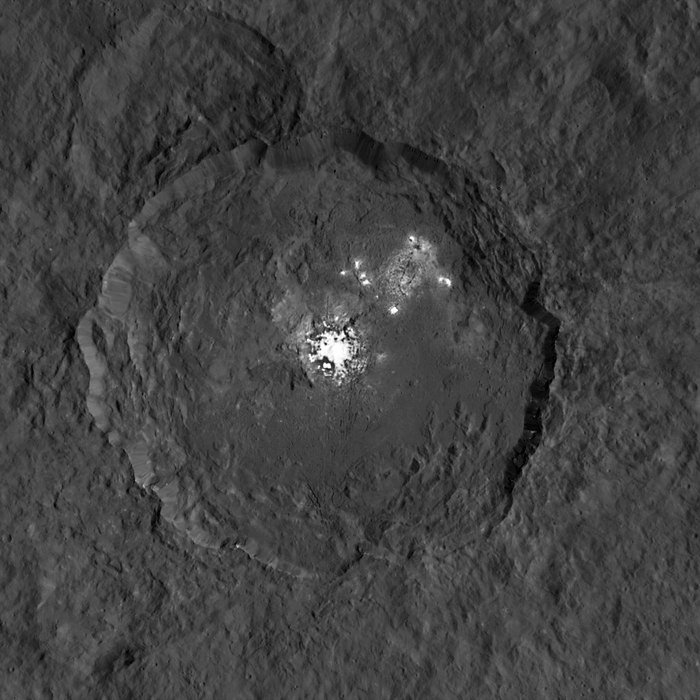
Beobachtungen mit dem HARPS-Spektrografen am La Silla-Observatorium der ESO in Chile haben unerwartete Veränderungen in hellen Flecken auf dem Zwergplaneten Ceres zu Tage gebracht. Obwohl Ceres von der Erde aus nur als etwas hellerer Lichtpunkt erscheint, zeigt sich bei hochpräzisen Untersuchungen des von Ceres ausgesandten Lichts nicht nur die Veränderung, die man durch die Rotation des Zwergplaneten erwarten würde, sondern auch, dass die Flecken am Tag aufhellen und außerdem noch andere Schwankungen aufweisen. Diese Beobachtungen weisen darauf hin, dass die Materie dieser Flecken flüchtig ist und im warmen Sonnenlicht verdunstet.
Ceres stellt den größten Körper im Asteroidengürtel zwischen Mars und Jupiter dar und ist das einzige dieser Objekte, das als Zwergplanet eingestuft wird. Die Dawn-Raumsonde der NASA befindet sich seit mehr als einem Jahr in der Umlaufbahn von Ceres und hat seine Oberfläche sehr detailliert kartiert. Eine der größten Überraschungen dabei ist die Entdeckung sehr heller Flecken gewesen, die um einiges mehr Licht reflektieren, als ihre deutlich dunklere Umgebung [1]. Der markanteste dieser Flecken liegt innerhalb des Occator-Kraters und weist darauf hin, dass Ceres eine deutliche lebhaftere Welt als die meisten seiner Asteroiden-Nachbarn sein könnte.
Neue und sehr präzise Beobachtungen mit dem HARPS-Spektrografen am 3,6-Meter-Teleskop der ESO auf La Silla in Chile haben jetzt nicht nur die Bewegung der Flecken aufgrund der Rotation von Ceres um ihre Achse entdeckt, sondern fanden auch unerwartete zusätzliche Veränderungen, die darauf hinweisen, dass die Materie in den Flecken flüchtig ist und im Sonnenlicht verdunstet.
Paola Molaro vom INAF-Astronomischen Observatorium in Trieste, der Estautor der Studie, erzählt: „Als die Dawn-Raumsonde die mysteriösen hellen Flecken auf der Oberfläche von Ceres zeigte, dachte ich sofort an die möglichen messbaren Effekte von der Erde aus. Wenn Ceres rotiert, nähern sich die Flecken der Erde und entfernen sich wieder, was das Spektrum des reflektierten Sonnenlichts beeinflusst, das die Erde erreicht.“
Ceres dreht sich einmal in neun Stunden um sich selbst und Berechnungen zeigten, dass der Effekt durch die Bewegung der Flecken in Richtung zur Erde und von ihr weg aufgrund der Rotation sehr gering sein würden: in der Größenordnung von nur 20 Kilometern pro Stunde. Diese Bewegung ist jedoch ausreichend, um über den Doppler-Effekt mit Hochpräzessionsinstrumenten wie HARPS nachgewiesen werden zu können.
Das Team beobachtete Ceres mit HARPS für etwas mehr als zwei Nächte im Juli und August 2015. „Das Ergebnis war eine Überraschung“, fügt Antonino Lanza vom INAF-Astrophysikalischen Observatorium in Catania und Koautor der Studie hinzu. „Wir haben die erwarteten Änderungen im Spektrum aufgrund der Rotation von Ceres gefunden, aber mit erheblichen Schwankungen von Nacht zu Nacht.“
Das Team kam zu dem Schluss, dass der Grund für die beobachteten Änderungen im Vorhandensein flüchtiger Substanzen zu finden sein könnte, die unter dem Einfluss der Sonneneinstrahlung verdunstet [2]. Wenn sich die Flecken innerhalb des Occator-Kraters auf der Seite befinden, die von der Sonne angestrahlt wird, bilden sich Schwaden, die das Sonnenlicht sehr wirksam reflektieren. Diese Schwaden verdunsten dann kurzerhand, verlieren an Reflexionsvermögen und bewirken die beobachteten Veränderungen. Dieser Effekt ändert sich jedoch von Nacht zu Nacht, was zusätzliche zufällige Muster auslöst, sowohl auf kürzeren als auch auf längeren Zeitskalen.
Sollte sich diese Interpretation bestätigen, scheint es, als unterscheide sich Ceres sehr von Vesta und den anderen Asteroiden des Hauptgürtels. Obwohl sie räumlich relativ isoliert ist, scheint sie im Inneren aktiv zu sein [3]. Es ist bekannt, dass es auf Ceres reichlich Wasser gibt, es ist jedoch unklar, ob dies in Zusammenhang mit den hellen Flecken steht. Die Energiequelle, die diesen kontinuierlichen Austritt an Materie von der Oberfläche antreibt, ist ebenfalls noch unbekannt.
Dawn wird Ceres und das Verhalten der mysteriösen Flecken weiterhin untersuchen. Auch nach dem Ende der Weltraummission wird es möglich sein, mit HARPS und anderen Anlagen Beobachtungen vom Erdboden aus fortzuführen.
Endnoten
[1] Helle Flecken waren mit deutlicher weniger Klarheit auch in früheren Bildern von Ceres vom Hubble-Weltraumteleskop der NASA/ESA zu sehen, die zwischen 2003 und 2004 aufgenommen wurden.
[2] Man vermutet, dass es sich bei der hochreflektierenden Materie in den Flecken auf Ceres um frisch ausgetretenes Wassereis oder hydratisierte Magnesium-Sulfate handeln könnte.
[3] Viele der am im Inneren aktivsten Körper im Sonnensystem, wie die großen Trabanten von Jupiter und Saturn, sind aufgrund ihrer Nähe zu den massereichen Planeten starken Gezeitenkräften ausgesetzt.
Quelle: ESO
5504 Views
